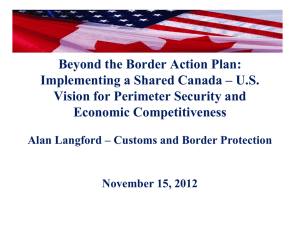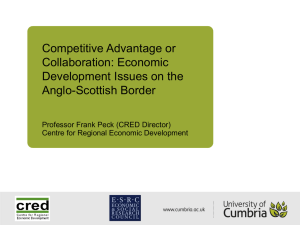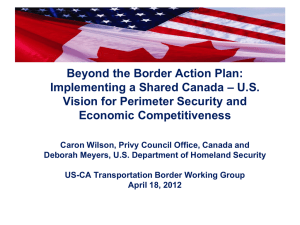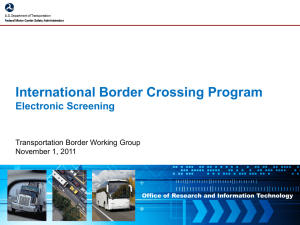cross-border residential mobility
advertisement
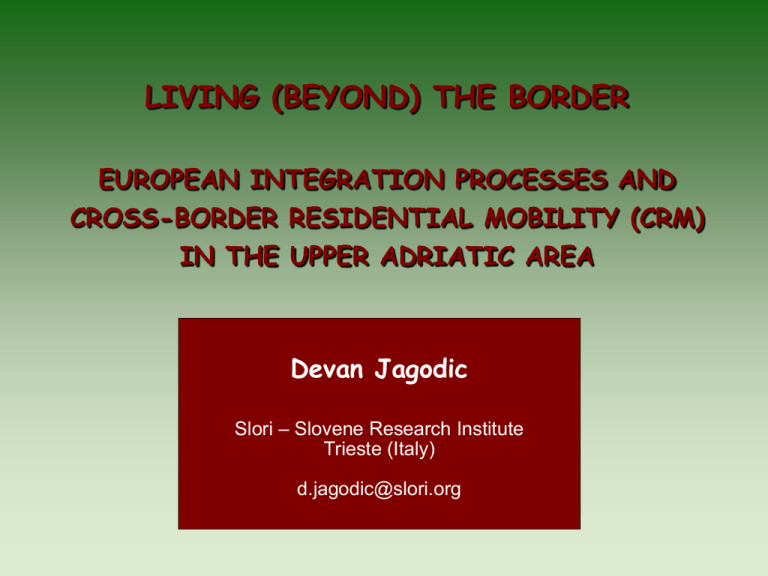
LIVING (BEYOND) THE BORDER EUROPEAN INTEGRATION PROCESSES AND CROSS-BORDER RESIDENTIAL MOBILITY (CRM) IN THE UPPER ADRIATIC AREA Devan Jagodic Slori – Slovene Research Institute Trieste (Italy) d.jagodic@slori.org CROSS-BORDER RESIDENTIAL MOBILITY (CRM) CRM as an emerging phenomenon of spatial mobility taking place in several EU “internal” borderlands Migration movements undertaken by people living in border areas, who decide to buy a house and move on the other side of the border Origins of the phenomenon (the “border paradox”): on the one side: explosion of CRM after acceleration of European integration processes during the 90’s ► consequence of the increasing permeability of physical and mental borders on the other side: cross-border migrants profit from asymmetries between two bordering areas (real estate market conditions, cost of living etc.) ► consequence of the long-lasting border-barriers LITERATURE REVIEW ON CRM: 4 CASE-STUDIES Dutch-German borderland (Strüver, 2005; Van Houtum & Gielis, 2006) German-French borderland (Terlouw, 2008) Danish-Swedish borderland (www.tendensoresund.org) Slovak-Hungarian borderland (Hardi, 2009) THEORETICAL FRAMEWORK (1) CRM AS AN EFFECT OF SUBURBANISATION OF BORDER CITIES CRM always the RESULT of the border cities’ expansion towards their metropolitan suburbs across the border Nijmegen (NL) ► Germany Karlsruhe (D) ► France København (DK) ►Sweden Bratislava (SK) ►Hungary Neighbouring rural areas becoming progressively residential suburbs of the cities, their “satellite settlements” THEORETICAL FRAMEWORK (2) CRM AS AN EFFECT OF SUBURBANISATION OF BORDER CITIES CAUSES for CRM typical of suburbanisation: • high residential density in cities • cheaper houses in peripheries • growing demand for larger houses out of the city centre and close to “nature” • improvement of road connections and increase of private motorisation • role of governmental authorities (urban policies, building permits, credit conditions etc.) THEORETICAL FRAMEWORK (3) CRM AS AN EFFECT OF SUBURBANISATION OF BORDER CITIES A series of SIDE EFFECTS deriving from the “elastic” way of life undertaken by cross-border migrants CRM as an “elastic migration” (Van Houtum & Gielis, 2006) = constant interaction between centrifugal forces (moving house in the new country) and centripetal forces (maintaining of functional and/or affective bonds with the country of origin) Daily cross-border commuting practices to/from the city (work, bring children to chool, visits to parents, use of services, etc.) CROSS-BORDER RESIDENTIAL MOBILITY IN THE UPPER ADRIATIC AREA (1) The Italian-Slovenian borderland: rather sensible and controversial area several variations of the border line ► changes in political-institutional system, ethnic repressions, definitions of rigid borders after World War II: border represented the ideological line of division between West and East BUT, after the 60’s: border ever more permeable, development of cross-border mobility practices democratisation of Slovenia (1991) and its entrance in EU (2004) accelerated border crossing, giving birth to new mobility phenomena (CRM) CROSS-BORDER RESIDENTIAL MOBILITY IN THE UPPER ADRIATIC AREA (2) European integration processes + weakening of the border barriers + liberalization of the Slovenian real estate market ►Development of cross-border flows of residential mobility in the Italian-Slovenian border area Main directions: rural villages of the Slovenian Carst laying near close to the national border with Italy New Slovenian Carst inhabitants = urban population coming from Trieste, border city and capital of Friuli Venezia Giulia Region CROSS-BORDER RESIDENTIAL MOBILITY IN THE UPPER ADRIATIC AREA (3) Suburbanization of Trieste crossing the national border CROSS-BORDER RESIDENTIAL MOBILITY IN THE UPPER ADRIATIC AREA (4) REASONS for moving beyond the border: a) economic motivations: differences in real estate prices !!! less bureaucracy minor costs for purchase fewer taxes and duties b) anti-urban motivations: better quality of life (green areas, fresh air, no pollution etc.) CROSS-BORDER RESIDENTIAL MOBILITY IN THE UPPER ADRIATIC AREA (5) Actors of CRM young couples looking for first house many of them had previous contacts with Slovenian language/culture (members of Slovenian minority in Trieste or relatives with Slovenian origins or have studied the language) migrants with no knowledge of Slovenian language = difficulties with the socio-cultural integration in the new environment CROSS-BORDER RESIDENTIAL MOBILITY IN THE UPPER ADRIATIC AREA (6) Cross-border migrants' way of life new residences located in the close vicinity of the border line, in order to facilitate the maintenance of contacts with the country of origin daily commuting with Trieste (work, school, social networks, free time, use of services) ► “elastic” way of life new domicile mostly used as a dormitory, a space where to enjoy “nature” in the free hours of the day and during weekends CROSS-BORDER RESIDENTIAL MOBILITY IN THE UPPER ADRIATIC AREA (7) PROBLEMATIC ASPECTS linked to progressive advancement of cross-border migration flows: a) environment b) landscape c) social aspects d) etno-linguistic aspects a) EVIRONMENT Slovenian Carst = morphological and geological specifities (“Carst phenomena”) Continuos building intervensions = threat for the preservation of the natural lansdcape Traffic pollution produced by daily commuting b) LANDSCAPE Traditional Karst architecture Advancement of “urban sprawl” c) SOCIAL ASPECTS Diffusion of urban ways of life linked to individualism and privatism ► spread of family-centred residential patterns Orientation towards Italy and little motivation to social integration in the new enivironment of living “Living” often reduced to “residing” ► contrast with traditional Carst rural way of life (social communities) d) ETNO-LINGUISTIC ASPECTS Main problem: little knowledge of Slovenian language among some new incomers ►part of the local population not inclined to communicate in Italian Cases of ethnic segregation within residential complexes at the margin of the rural villages ►few contacts with local population, mutual diffidence REACTIONS FROM LOCAL PUBLIC OPINION Lack of legal instruments, which allows a wide diffusion of “satellite settlements Development of the territory influenced by big investors, building lobbies and real estate agencies Mediatic slogans underlining the threat of the “invasion” from the Italian capital Development of a series of local “civil initiatives” CONCLUSIONS CRM = a controversial phenomenon, which could arise very different reactions: a) POSITIVE: “a laboratory for cross-border integration, which can contribute to overcome physical and mental barriers by creating transnational spaces” b) NEGATIVE: “a contamination of the national territory with exogenous elements” c) INTERMEDIATE: “a part of the dynamics of the life along the border; a normal consequence of the asymmetries between two neighbouring systems, caused by the presence of the border” CONCLUSIONS A o o o series of practical issues that national and local authorities are called to face: How to support integration of migrants in the new setting? How to manage possible situations of segregation or ethnic conflict? How to deal with fiscal issues, giving that migrants usually pay taxes in the country of origin but use some public services in the country of destination? What kind of cross-border cooperation is possible to develop in order to face these problems? THANKS FOR YOUR ATTENTION!!!

